Don't wanna be here? Send us removal request.
Photo
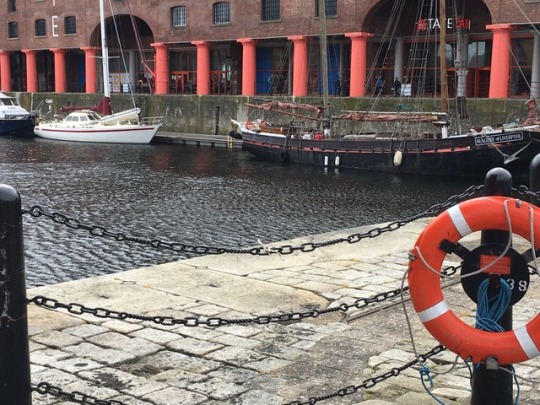
on 20/4/2017 we went on a trip to Liverpool, to gather inspirations on artists that might have given us some inspiration towards our final FMP.
we went in a kind of round route, from the Walker gallery to the Tate on Albert Dock. we went in the walker first, where a ranged of work was exhibited; from: The Transparency exhibition which was a visual collection, aiming at us trying to see things differently then what we are normally accustomed to, and in the other sections; it focused on conventional art from the 18th-20th Century, all ranging in its concepts and ambiguity, however you want to look at it.
Then we went on to the Bluecoat Gallery, there were some interesting pieces in there, very distinctive in appearance and symbolic attitudes. one in particular I liked was an untitled piece by Brian O'Toole, which depicts a skeleton watering a growing tree. I thought it was quite witty as the skeleton was giving a thumbs up whilst doing his task.
after we went to FACT where there was a replica of the Ecuadorian embassy where disgraced computer programmer, Julian Assagne lives. there was also an exhibit of Guantanamo bay and its interior on a digital viewpoint. and upstairs from there was a mockumentary about overplayed music with a fictional account of hated songs on a playlist CD that mocks its whole integrity of the music.
then lastly, the Tate in Liverpool,
0 notes
Photo


The differences between Mrs. Mounter, by Harold Gilman and The man and death by Joseph Wright.
Some of the differences as I can note from observation first is; the tone and atmosphere that radiates from the two; Gilman's work is based on actual real life events that is focusing on his tenant, Mrs. Mounter, and in the simplest form, displays the reality of aging in the slow manner which is accompanied by the assistance of old age.
Joseph Wright's work is based on a fabled tale from Greek storyteller, Aesop. It is a depiction of a woodcutter wanting to be relieved of his life and asks death to help him, death's untimely appearance startles the woodcutter and hastily changes his mind about the matter. one difference is this is just a story, a fable, which was most probably made up.
The two have similarities in form as the depiction of people; they have configured the aspects of their bodies and rightfully set in stone the atmosphere of the intended piece and concept. Both the colour usages are very distinctive, to both purposes, they share similarities in melancholy, to me they don't both spring out with vibrancy and contentment, to me they both speak out with everybody is going to meet the inevitable end at some point in their lives, whether its when you are young or old.
The perceptions of both pieces differ, Mrs. Mounter is looking directly at us, the audience, there's a tea kettle and cup which seems like an open invitation to join her and talk. also the configuration of the colour of her face may indicate that she has some sort of deteriorating illness of some kind, or just maybe that's her natural glow.
Wrights work represents a 3rd person view of an event shrouded by death, with a piercing light source that gives the question, is it a rising dawn? or a sunset ending? a watching event that seems to have more to tell, but is captured by this one still image. It's like a movie or a TV show that's been left on a cliffhanger, and the description next to the painting doesn't give much more information on the occurrence either.
1 note
·
View note
Text
UNIT 12 Evaluation
Unit 12 is about engaging with the audience and how their qualities and characteristics serve a purpose to the proposed question: ‘why do artists need a selected audience?’
This then interprets why do certain groups of people respond to art? And how do they relate to it in a way no one else would? And the simple reason being; there is just an appreciation for somebody’s work, it could be either they relate to it on a wider scale, it could also be that they have found something in an art form that is similar to themselves in quite a few ways, they have a common ground.
In my work that i had been working on for the last couple of months, i focused on my dreams that i had been having and proposed, ‘Do dreams affect our mood when we wake up?’ i had to think of a certain audience that may have related to my concept and either liked it for its eerie demeanour or simply the fact that they dreamt of the same things every night as do I. I can’t particularly think of any certain group of people in mind, however i think psychologists might have a curiosity about what i produce due to its’ dark nature.
Artists like Yves Klein whose art was a cross of ambience and performance art attracted an audience of a certain quality as during his lifetime the subject of his work didn’t allow him to be part of the mainstream, thus, being put in an art underground scene where only select people of his following knew about, making him then and even maybe now still an obscure artist. The kinds of research activities to carry out on a selected artists’ audience could be brainstorms, selected society questions of what people want to expect in their work. Also, find the right crowd, in a sense figure out what kind of audience would be your ideal and then seek out that crowd in a subtle way so then you can draw them out like moths to a flame. In Ancoats in Manchester, is a mural dedicated to mental health by German artist Andreas Von Chrzanowski aka CASE. The piece depicts the still ongoing struggles with mental health in men, which according to statistics, is the biggest cause of death for young men in the UK. On Ancoats is a place called 42nd street, which is a counselling unit for young people, maybe this is linked in with the mural and the counselling, or maybe it is autobiographical to share with the public, for them to relate and think, we are not alone. It has been directly painted on the wall on a very large scale, 3
For the dream purposes’ i had documented them directly from waking up and onto paper. i studied up on certain artists that i could try and get inspiration from including; Marc Chagall and Frank Auerbach. Because of the nature of the topic, my dreams were often filled with anxiety and sometimes fear (mostly anxiety) i wanted a darker looking approach because the unsettling images just deserved that bit of an edge and characteristic with a uniqueness opted with some simplicity. I did start by documenting my dreams through painting inspired by german artist Franz Marc then i saw the works of Francis Bacon and Frank Auerbach and found a mutual grounding on the eerie psyche of their work and the opted on making a change to the approach than rather from what i was seeing but how i was reporting it on another level.The materials i had used in the beginning had been acrylic and watercolour based paint, then i moved to the simpler methods of charcoal and chalk which then did work in my favour. I then thought about the sized chalk i would want to use on the dreams i was making, whether the markings made significant impact on the outcome or maybe even emphasised some characteristics. i felt like i chose the right charcoal for the outcomes i practiced they made faint guidelines in the start of the process and then i could add more in darker shades and sizes. white chalk proved effective also as used in small quantities gave the figures depth in shadow and stature.
I felt like i have made 2 big steps in the final outcome, i produced 2 large scale pieces on a wall scale, depicting 2 variations, 1 being a duplicate of a dream and the other being an almost truthful version of how i feel like these negative thoughts can come across in a metaphorical way. i feel like i would be happy for a final outcome to be the 2 brown paper scales merged together and make the biggest piece imaginable. My practical skills worked as to plan for the scale and how those figures fit in with each other on paper in an order of individuality and relevance.
0 notes
Photo
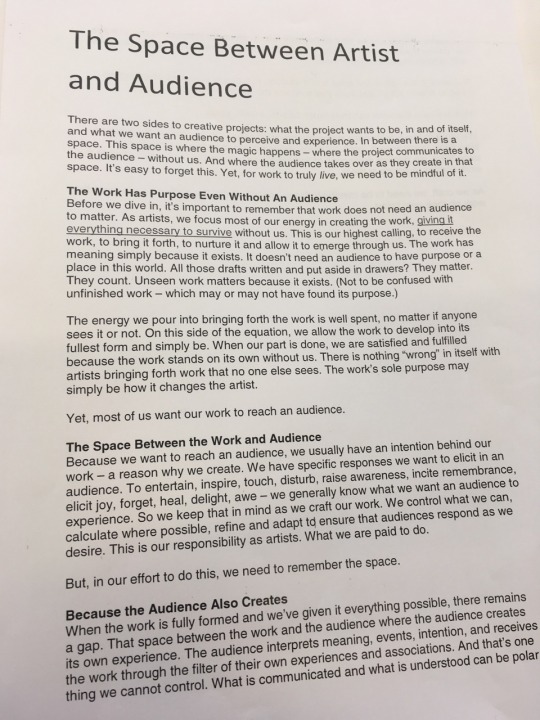
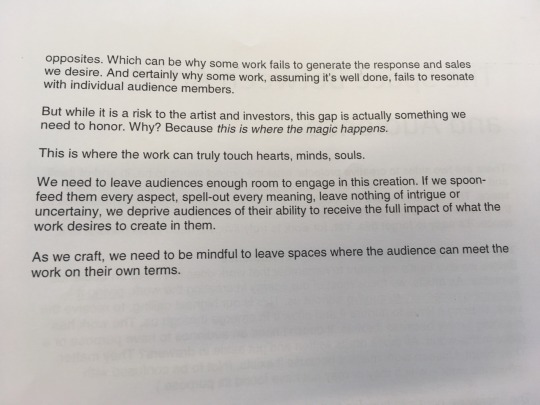
The main purpose of the article is to compare the concept of how audiences and art work are of a compatible nature.
The description of the necessary qualities to survive without a purpose strives in the fact that unseen work isn’t unfinished work; maybe it hasn’t targeted its specific audience, but, it does have its own unique purpose all in all.
Sometimes some work doesn’t appeal to a target audience but the self satisfaction of the build up to the piece is an achievement in itself.
1 note
·
View note
Photo
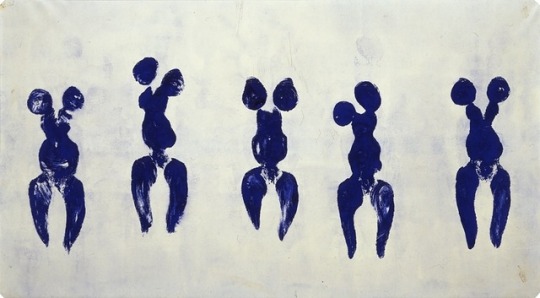
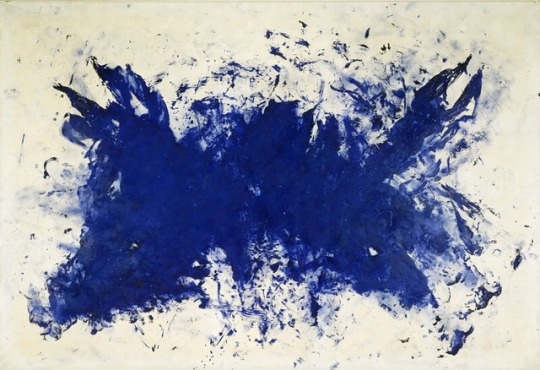

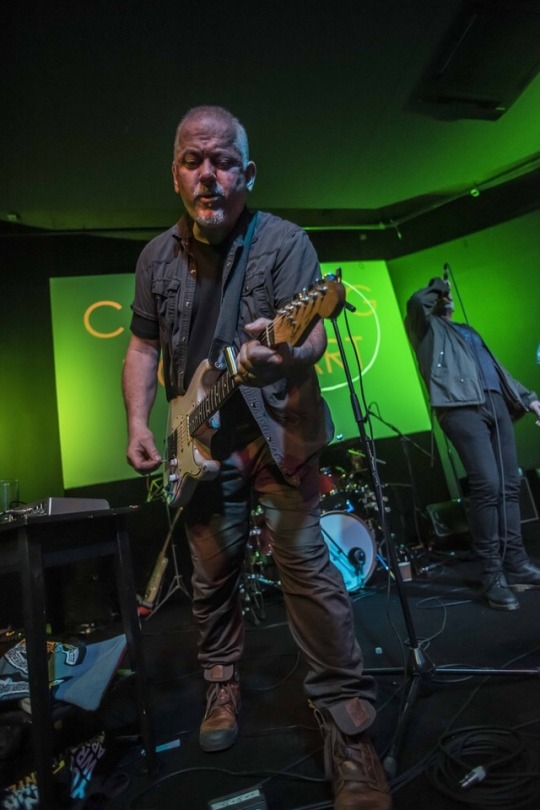
Yves Klein was a pioneer in the development of performance art, and is seen as an inspiration to, and as a forerunner of, Minimal art, as well as Pop art. John Hyatt, artist, musician, punk professor and one third of the infamous 1980’s post-punk band, The Three Johns. The similarities between these two are the link in performance art, Klein used paint and ambient music within his realm, he posed as the conductor to his own creativity as does John Hyatt with his performance art within the punk genre. Punk and art go hand in hand really, both mediums incorporate a DIY ethic, the art movement of performance art was a very much underground scene as it defied the norms of the mainstream as did punk when it came to light when it formed in the 1970's
0 notes
Photo
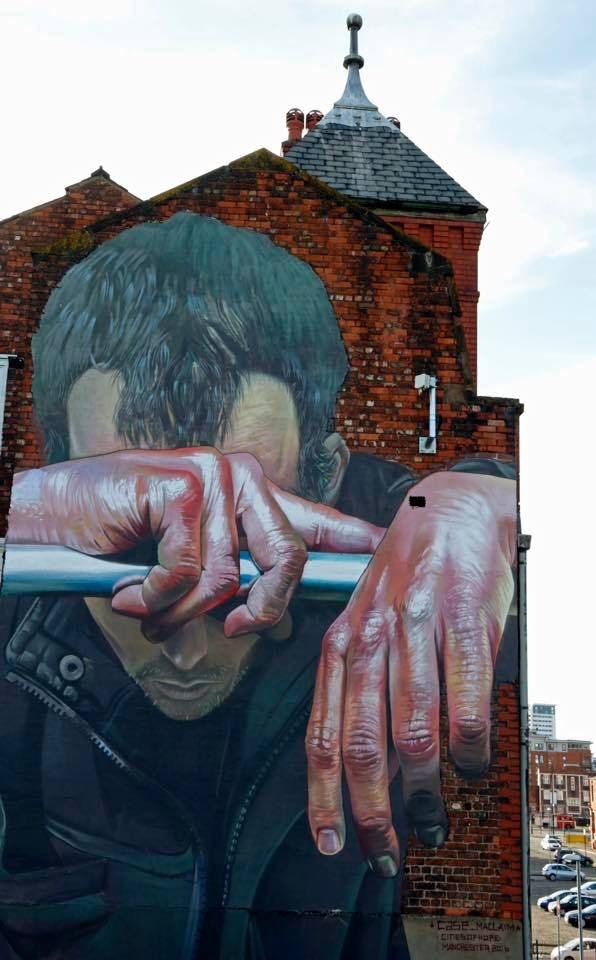
In this piece on Ancoats in Manchester, is a mural dedicated to mental health by German artist Andreas Von Chrzanowski aka CASE.
The piece depicts the still ongoing struggles with mental health in men, which according to statistics, is the biggest cause of death for young men in the UK. On Ancoats is a place called 42nd street, which is a counselling unit for young people, maybe this is linked in with the mural and the counselling, or maybe it is autobiographical to share with the public, for them to relate and think, we are not alone.
It has been directly painted on the wall on a very large scale, 3
0 notes
Photo
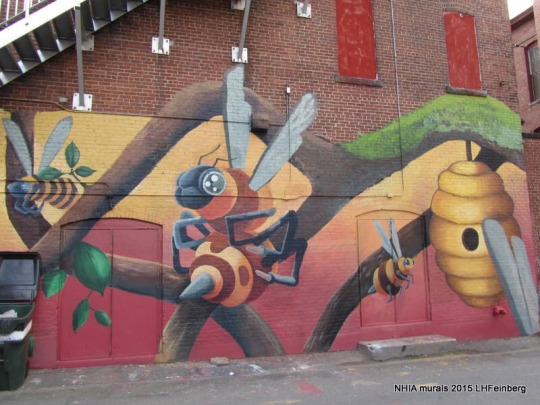
This depicts the conclusion of Manchester being famous for the bees. In Manchester during the industrial revolution of the 1800′s the Worker Bee persona was adopted due to the new mass production of cotton. The bee was adopted for the Mancunian work ethic that has a strong presence with the working community in the 19th century.
As a result, the markings are positioned on various locations all around the manchester area, the bee can be seen on lampposts, pillars, on the crest of Manchester.
Maybe the commentary reflects to a modern day aspect of the workers, because Manchester still remains to this day, a very prominent and thriving business powerhouse. so the basis of that reflection could annotate modern society.
0 notes
Photo

‘B of the Bang’ was a sculpture by Thomas Heatherwick that was commissioned in 2003 to tie in with the 2002 commonwealth games; from a quotation by British athlete, Linford Christie: ‘I don't start the races not at the bang of the pistol, but at the B of the Bang.’
The B of the Bang serves as a direct response to the quotation and the events of the commonwealth games, to tie in with the sports city complex for public adornment and appreciation of the games.
the piece is not a direct interactive sculpture, however, the piece has drew some controversy, such as the spikes from the complex detaching itself from the higher spikes of the sculpture. which issued for its dismantled position and being set aside in storage for the safety of the public.
0 notes
Photo
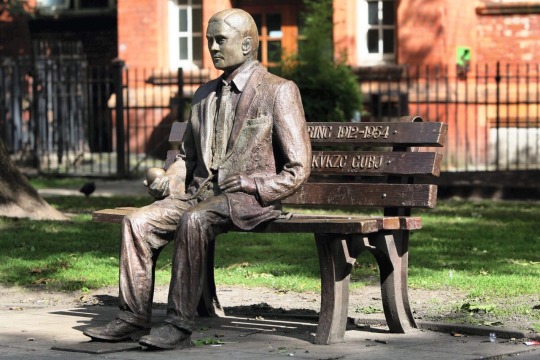
The Alan Turing memorial sits in the Sackville Gardens in Manchester. To commemorate the services of Alan Turing, a pioneer of modern day computing. The life-size bronze figure, made by Glyn Hughes in 2001 again remains in the Sackville Gardens.
One of the reasons he is situated outside in Sackville Gardens is because Turing was homosexual, thus, he is often cited as a gay icon added to his computer science, it was no coincedence that his statue is situated near Canal Street, Manchester’s gay village.
it is an interactive piece so it gives the options of sitting next to the sculpture in public or you can leave your respects and place flowers if needs be. it is for anyone in the public to celebrate or commemorate.
0 notes